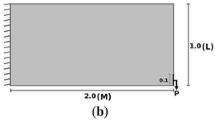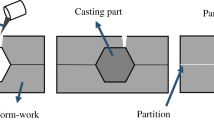Abstract
Discrete variable topology optimization problems are usually solved by using solid isotropic material with penalization (SIMP), genetic algorithms (GA), or mixed-integer nonlinear optimization (MINLO). In this paper, we propose formulating discrete ply-angle and thickness topology optimization problems as a mixed-integer second-order cone optimization (MISOCO) problem. Unlike SIMP and GA methods, MISOCO efficiently finds the problem’s globally optimal solution. Furthermore, in contrast with existing MISOCO formulations of discrete ply-angle optimization problems, our reformulations allow the structure to change topology, consider the more realistic Tsai–Wu stress yield criteria constraint, and eliminate checkerboard patterns using simple linear constraints. We address two types of discrete ply-angle and thickness problems: a structural mass minimization problem and a compliance optimization problem where the objective is to maximize the structural stiffness. For each element, one first chooses if the element is present or not in the structure. One can then choose the element’s ply-angle and thickness from a finite set of possibilities for the former case. The discrete design space for ply-angle and thickness is a result of manufacturing limitations. To improve the problem’s MISOCO solution approach, we develop valid inequality constraints to tighten the continuous relaxation of the MISOCO reformulation. We compare the performance of various MISOCO solvers: Gurobi, CPLEX, and MOSEK to solve the MISOCO reformulation. We also use BARON to solve the original MINLO formulations of the problems. Our results show that solving the MISOCO problem’s formulation using MOSEK is the most efficient solution approach.















Similar content being viewed by others
Notes
https://SichengHe@bitbucket.org/SichengHe/misoco_composite.git.
References
Achtziger W, Stolpe M (2009) Global optimization of truss topology with discrete bar areas—part II: implementation and numerical results. Comput Optim Appl 44(2):315–341
Albanesi A, Bre F, Fachinotti V, Gebhardt C (2018) Simultaneous ply-order, ply-number and ply-drop optimization of laminate wind turbine blades using the inverse finite element method. Compos Struct 184:894–903
Andersen ED, Andersen KD (2000) The MOSEK interior point optimizer for linear programming: an implementation of the homogeneous algorithm. In: Frenk H, Roos K, Terlaky T, Zhang S (eds) Applied optimization. Springer, Berlin, pp 197–232
Andersen ED, Roos K, Terlaky T (2003) On implementing a primal-dual interior-point method for conic quadratic optimization. Math Program 95(2):249–277
Belotti P, Góez JC, Pólik I, Ralphs TK, Terlaky T (2013) On families of quadratic surfaces having fixed intersections with two hyperplanes. Discrete Appl Math 161(16–17):2778–2793
Belotti P, Góez JC, Pólik I, Ralphs TK, Terlaky T (2017) A complete characterization of disjunctive conic cuts for mixed integer second order cone optimization. Discrete Optim 24:3–31
Bendsøe MP, Sigmund O (1999) Material interpolation schemes in topology optimization. Arch Appl Mech (Ingenieur Archiv) 69(9–10):635–654
Bourdin B (2001) Filters in topology optimization. Int J Numer Methods Eng 50(9):2143–2158
Brampton CJ, Wu KC, Kim HA (2015) New optimization method for steered fiber composites using the level set method. Struct Multidiscip Optim 52(3):493–505
Brooks TR, Martins JRRA (2018) On manufacturing constraints for tow-steered composite design optimization. Compos Struct 204:548–559
Bruyneel M (2011) SFP—a new parameterization based on shape functions for optimal material selection: application to conventional composite plies. Struct Multidiscip Optim 43(1):17–27
Cheng G (1995) Some aspects of truss topology optimization. Struct Optim 10(3–4):173–179
Cheng GD, Guo X (1997) \(\epsilon\)-relaxed approach in structural topology optimization. Struct Optim 13(4):258–266
Díaz A, Sigmund O (1995) Checkerboard patterns in layout optimization. Structural Optimization 10(1):40–45
Ghiasi H, Fayazbakhsh K, Pasini D, Lessard L (2010) Optimum stacking sequence design of composite materials part II: variable stiffness design. Compos Struct 93(1):1–13
Gillet A, Francescato P, Saffre P (2010) Single- and multi-objective optimization of composite structures: the influence of design variables. J Compos Mater 44(4):457–480
Grossmann IE, Voudouris V, Ghattas O (1992) Mixed-integer linear programming reformulations for some nonlinear discrete design optimization problems. In: Floudas CA, Pardalos PM (eds) Recent advances in global optimization. Princeton University Press, Princeton, pp 478–512
Gurobi Optimization, LLC (2018) Gurobi optimizer reference manual
Haftka RT (1985) Simultaneous analysis and design. AIAA J 23(7):1099–1103
Haftka RT, Walsh JL (1992) Stacking-sequence optimization for buckling of laminated plates by integer programming. AIAA J 30(3):814–819
Hahn HT, Tsai SW (1980) Introduction to composite materials. Technomic Publishing Co., Inc., New York
Huang D, Friedmann PP (2016) An integrated aerothermoelastic analysis framework for predicting the response of composite panels. In: 15th dynamics specialists conference. American Institute of Aeronautics and Astronautics
IBM ILOG (2018) IBM ILOG CPLEX v12.8.0 user’s manual for CPLEX
Kennedy GJ (2016) A full-space barrier method for stress-constrained discrete material design optimization. Struct Multidiscip Optim 54(3):619–639
Kennedy GJ, Martins JRRA (2013) A laminate parametrization technique for discrete ply-angle problems with manufacturing constraints. Struct Multidiscip Optim 48(2):379–393
Kim JS, Kim CG, Hong CS (1999) Optimum design of composite structures with ply drop using genetic algorithm and expert system shell. Compos Struct 46(2):171–187
Lobo MS, Vandenberghe L, Boyd S, Lebret H (1998) Applications of second-order cone programming. Linear Algebra Appl 284(1–3):193–228
Marmaras K (2014) Optimal design of composite structures under manufacturing constraints. PhD thesis, Technical University of Denmark
Martins JRRA, Lambe AB (2013) Multidisciplinary design optimization: a survey of architectures. AIAA J 51(9):2049–2075
McCormick GP (1976) Computability of global solutions to factorable nonconvex programs: part I—convex underestimating problems. Math Program 10(1):147–175
Mela K (2014) Resolving issues with member buckling in truss topology optimization using a mixed variable approach. Struct Multidiscip Optim 50(6):1037–1049
Munoz E (2010) Global optimization for discrete topology design problems by generalized Benders’s decomposition. PhD thesis, Technical University of Denmark
Nikbakt S, Kamarian S, Shakeri M (2018) A review on optimization of composite structures part I: laminated composites. Compos Struct 195:158–185
Petersen CC (1971) A note on transforming the product of variables to linear form in linear programs. Working paper, Purdue University
Rasmussen MH, Stolpe M (2008) Global optimization of discrete truss topology design problems using a parallel cut-and-branch method. Comput Struct 86(13–14):1527–1538
Riche RL, Haftka RT (1993) Optimization of laminate stacking sequence for buckling load maximization by genetic algorithm. AIAA J 31(5):951–956
Sahinidis NV (2017) BARON 17.8.9: global optimization of mixed-integer nonlinear programs. User’s manual
Shahabsafa M, Mohammad-Nezhad A, Terlaky T, Zuluaga L, He S, Hwang JT, Martins JRRA (2018) A novel approach to discrete truss design problems using mixed integer neighborhood search. Struct Multidiscip Optim 58(6):2411–2429
Shahabsafa M, Fakhimi R, Lei W, He S, Martins JRRA, Terlaky T, Zuluaga LF (2020) Truss topology design and sizing optimization with guaranteed kinematic stability. Struct Multidiscip Optim. https://doi.org/10.1007/s00158-020-02698-x
Sigmund O (1997) On the design of compliant mechanisms using topology optimization. Mech Struct Mach 25(4):493–524
Sigmund O, Petersson J (1998) Numerical instabilities in topology optimization: a survey on procedures dealing with checkerboards, mesh-dependencies and local minima. Struct Optim 16(1):68–75
Sørensen R, Lund E (2015) Thickness filters for gradient based multi-material and thickness optimization of laminated composite structures. Struct Multidiscip Optim 52(2):227–250
Sørensen SN, Stolpe M (2015) Global blending optimization of laminated composites with discrete material candidate selection and thickness variation. Struct Multidiscip Optim 52(1):137–155
Stegmann J, Lund E (2005) Discrete material optimization of general composite shell structures. Int J Numer Methods Eng 62(14):2009–2027
Stolpe M (2007) On the reformulation of topology optimization problems as linear or convex quadratic mixed 0–1 programs. Optim Eng 8(2):163–192
Stolpe M (2014) Truss topology optimization with discrete design variables by outer approximation. J Glob Optim 61(1):139–163
Stolpe M, Stidsen T (2007) A hierarchical method for discrete structural topology design problems with local stress and displacement constraints. Int J Numer Methods Eng 69(5):1060–1084
Stolpe M, Svanberg K (2003) Modelling topology optimization problems as linear mixed 0–1 programs. Int J Numer Methods Eng 57(5):723–739
Sved G, Ginos Z (1968) Structural optimization under multiple loading. Int J Mech Sci 10(10):803–805
Tawarmalani M, Sahinidis NV (2005) A polyhedral branch-and-cut approach to global optimization. Math Program 103(2):225–249
Tsai SW, Wu EM (1971) A general theory of strength for anisotropic materials. J Compos Mater 5(1):58–80
Zhou Y, Nomura T, Saitou K (2018) Multi-component topology and material orientation design of composite structures (MTO-C). Comput Methods Appl Mech Eng 342:438–457
Acknowledgements
This research was supported by Air Force Office of Scientific Research Grant No. FA9550-15-1-0222. We thank Prof. Sahinidis for providing us a license for the BARON software.
Author information
Authors and Affiliations
Corresponding author
Additional information
Publisher's Note
Springer Nature remains neutral with regard to jurisdictional claims in published maps and institutional affiliations.
Appendix
Appendix
1.1 Constitutive matrix calculation
1.1.1 In-plane constitutive relation
In this section, we present the constitutive matrix \({\mathbf {Q}}_i\) derivation procedures. In a frame that the x axis is aligned with the fiber direction, we have the following constitutive relationships:
where \({\mathbf {Q}}\) is given as
and
For more general cases where the x axis and the fiber direction are with an angle of \(\theta\), using the laws of tensor transformation relations, we have:
where
and
Thus, the general constitutive law is given as:
For the jth choice with the angle as \(\theta _j\), we define:
We can give an explicit expression for \({\mathbf {Q}}_j\) by expanding the previous equation:
1.1.2 Out-of-plane constitutive relation
The out-of-plane constitutive relationship is given as
where
and
We also know that \(C_{44}=G_{23}\) and \(C_{55}=G_{12}\).
1.2 Strain operator
We calculate the strain of the upper surface center for each element that is later used in Tsai–Wu failure criterion. The in-plane strain is given as:
where
For the shape function \(N_i\), we have
To evaluate the strain of the center point over the top surface, we simply set \((\eta , \xi , z)=(0, 0, h/2)\). Finally,
1.3 Local stiffness matrix calculation
In this section, we present the derivation of the local stiffness matrix \({\mathbf {K}}_{ij}\) derivation, which is based on classic lamination theory (CLT). We begin the derivation by giving the expression for matrices \({\mathbf {A}}, {\mathbf {B}}, {\mathbf {D}}\) representing the extensional stiffness matrix, the coupling stiffness matrix and the bending stiffness matrix, respectively:
The traverse shear stiffness matrix is given as:
where \(\kappa =\frac{5}{6}\). Notice that to be consistent with the assumption made in this paper here we assume that there is only one layer of material.
We now present the stiffness matrix expression:
Then we apply the Gaussian quadrature for numerical integration. For \(K_{ij,L_1}\), we apply \(3\times 3\) integration points; while for \(K_{ij,L_2}\), we apply \(2\times 2\) integration points. This helps to avoid “shear locking”.
1.4 A brief overview of SOC
A SOC constraint can be expressed in the following format (Lobo et al. 1998)
where \(\Vert {\cdot }\Vert\) denotes the Euclidean norm, \({\mathbf {x}}\in {{\mathbb {R}}}^n\) is the variable vector, \({\mathbf {A}} \in {{\mathbb {R}}}^{m \times n}\), \({\mathbf {b}}\in {{\mathbb {R}}}^{m}\), \({\mathbf {c}}\in {{\mathbb {R}}}^n\), and \(d\in {{\mathbb {R}}}\).
A SOC constraint appears naturally when the feasible set of a convex quadratic function is considered. In particular, let \({\mathbf {Q}}\) be PSD, then
is equal to the following set
Many more examples, including truss topology optimization problems, showing how SOC constraints arise in practice are discussed by Lobo et al. (1998).
Rights and permissions
About this article
Cite this article
He, S., Shahabsafa, M., Lei, W. et al. Mixed-integer second-order cone optimization for composite discrete ply-angle and thickness topology optimization problems. Optim Eng 22, 1589–1624 (2021). https://doi.org/10.1007/s11081-020-09573-0
Received:
Revised:
Accepted:
Published:
Issue Date:
DOI: https://doi.org/10.1007/s11081-020-09573-0




